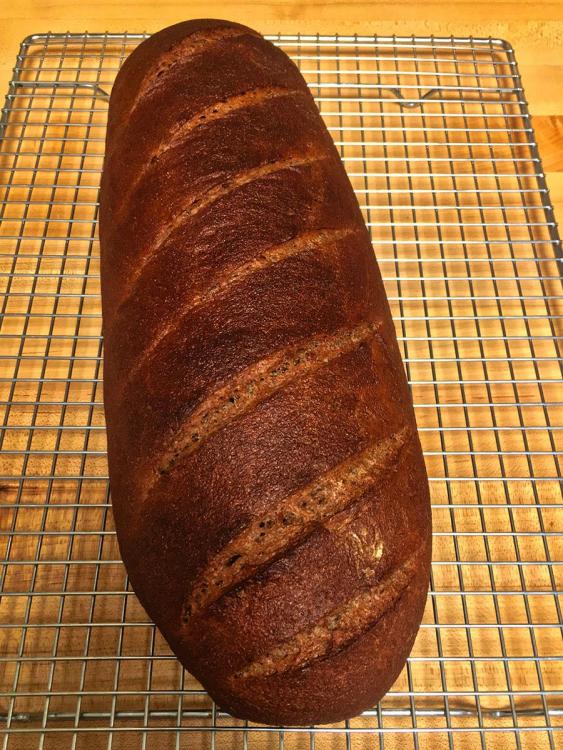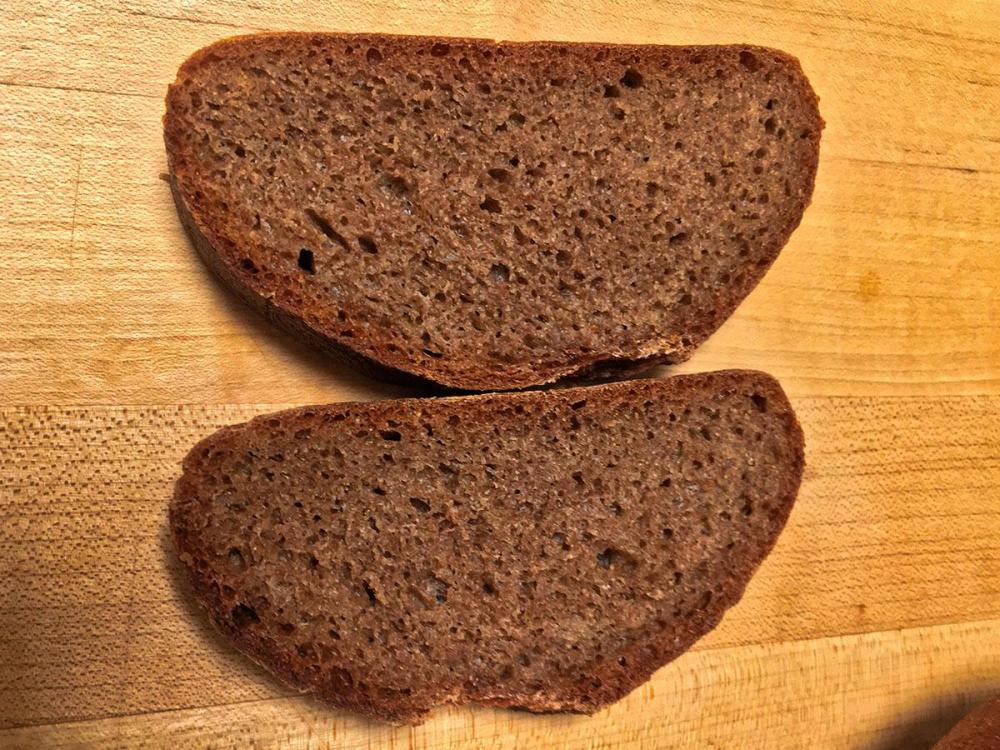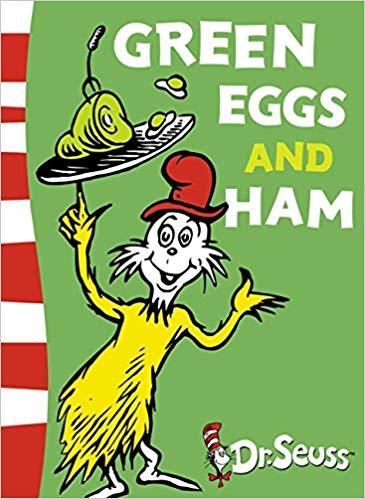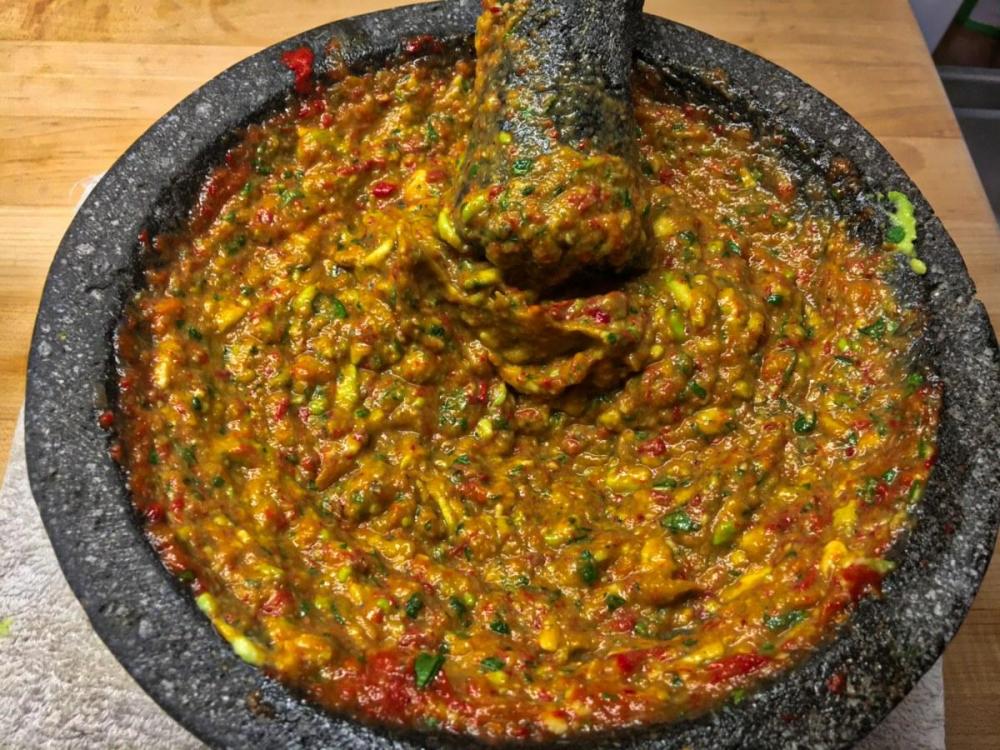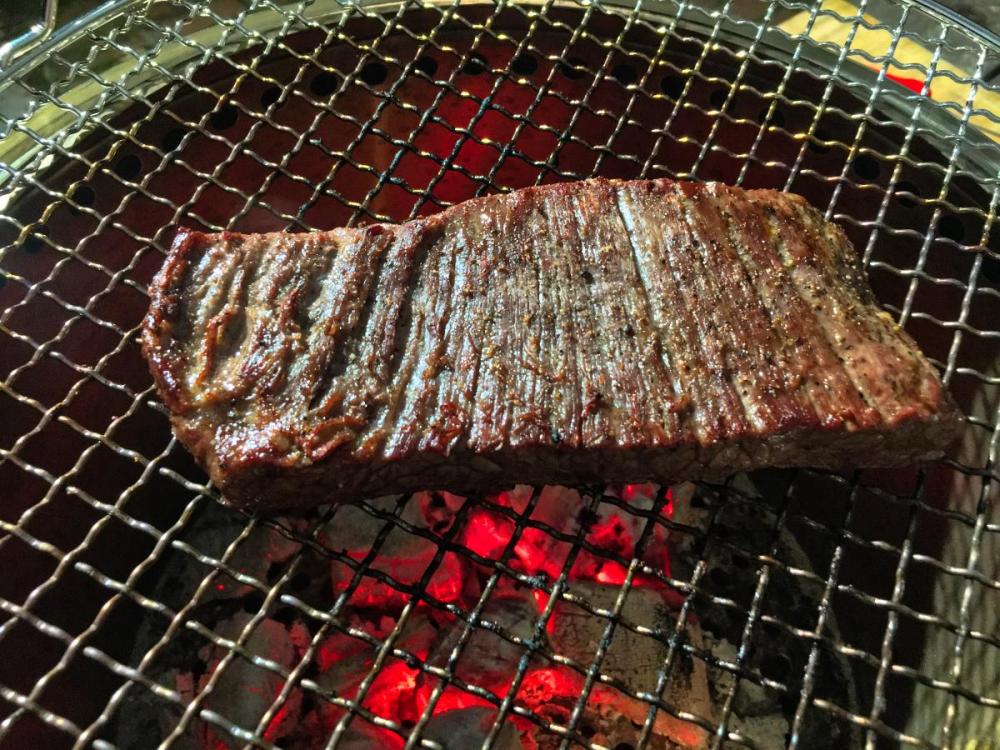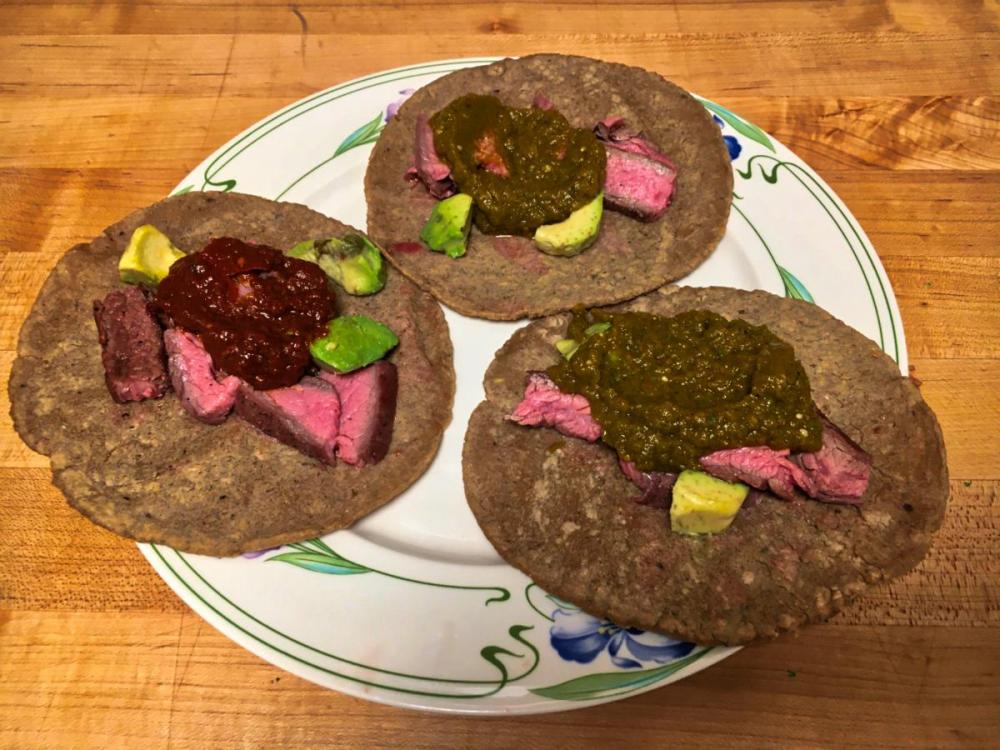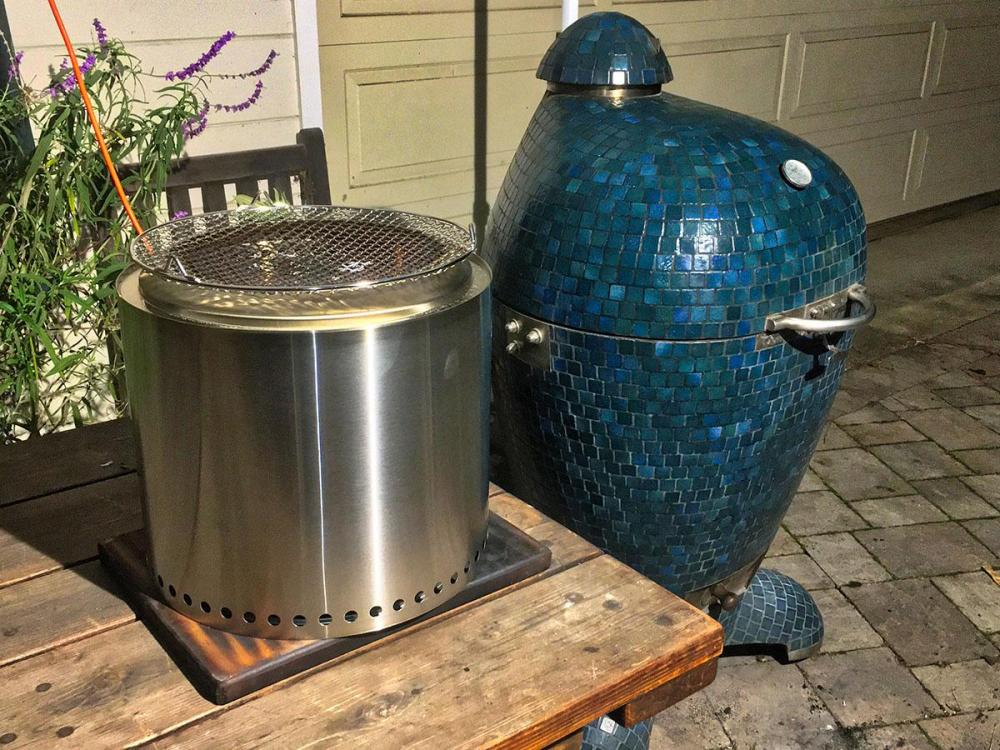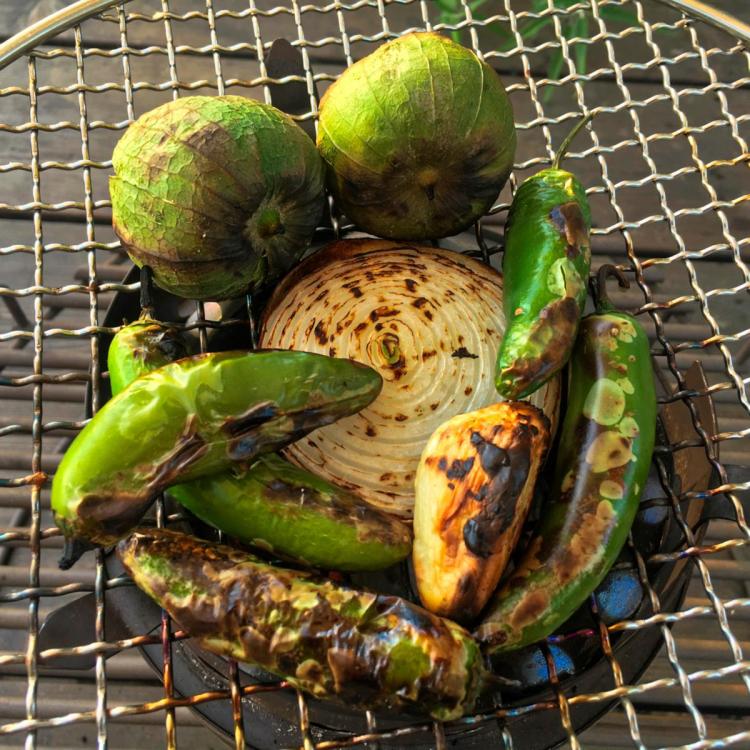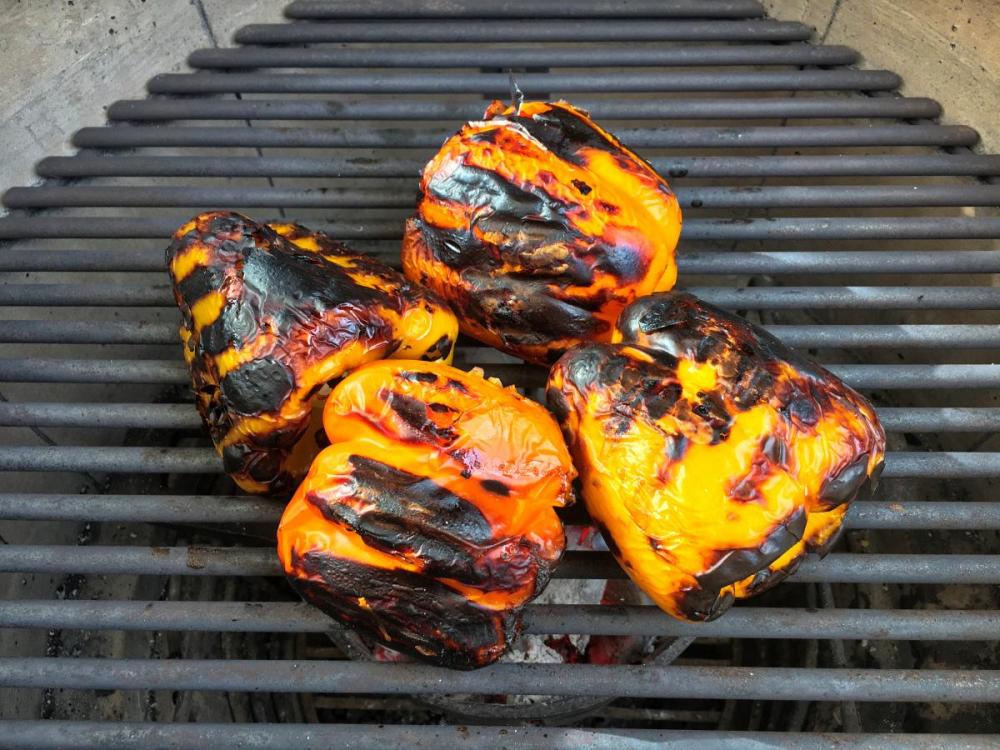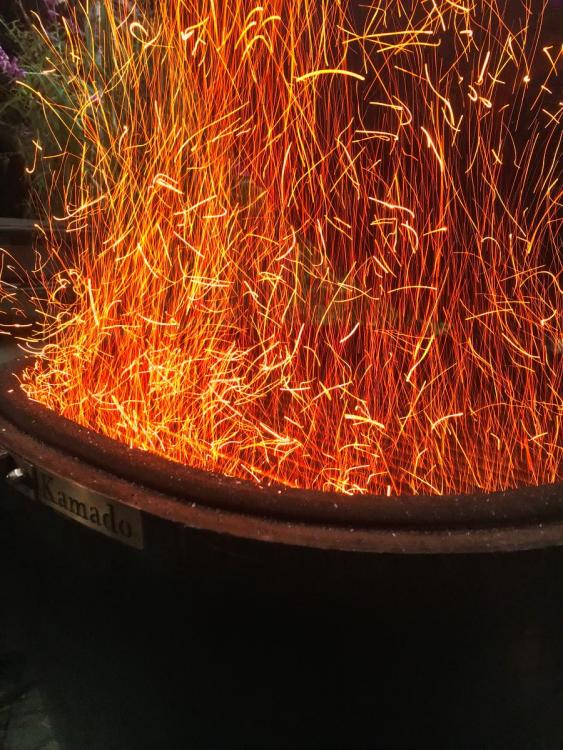-
Posts
1,747 -
Joined
-
Last visited
-
Days Won
53
Content Type
Profiles
Forums
Events
Everything posted by Syzygies
-
How did you sprout the rye? My last loaf was also in a loaf pan. It felt like a crisis of principles, but it was in fact liberating to not have to restrict myself to doughs that can support themselves.
-
You are my hero! 60% kamut, 90% hydration? Wow. That's unexplored territory for me.
-
It amazes me how these gun-toting idiots can't identify their true enemies. As far as I can tell, they actually vote for their true enemies. If they ever figured that out, at least we'd come out of this crisis with better gun control.
-
Organic Durum Wheat! Let us know how that turns out, we weren't happy with our source. I had hoped to at least make it our primary wheat for pasta, but I was just name-matching. We like Hard Red best, mixed down with semolina flour. I ordered our Durum Wheat kernels in New York (my work apartment) and flew half of it to California (our home). At JFK security I was selected for testing, perhaps because this looked odd on the X-ray. As an aside, I used to fly a lot, and I'm no stranger to unusual experiences at airport security. After we moved my Mom from Maine to California, we were closing up her house to sell, and I took responsibility for transporting what we hadn't scattered of my Dad's ashes. Now, we're a bit of an odd family, and these ashes had a storied history. My wife and I were on the phone with my Mom when the box came by postal mail, and she brightly said "Oh, your Dad's home!" He had died from dementia, but the proximate cause was thirst once he couldn't swallow. When I next saw the ashes box, it was still unopened, but there was a bottle of spring water on top. I cautiously asked my Mom if there was any significance to this? No, it was an available horizontal surface. Finally, my family gathered to scatter his ashes from Peaks Island, and my Mom asked that we reserve some ashes for her to keep. We lined a ball jar with some red tissue, and I took the still-unopened box down to the cellar, to my Dad's old workbench. Irish Catholic Mom, woodworking hobbyist Dad. Alter, workbench. Made sense to me. My sister came down to see the proceedings, and exclaimed in shock that I was spilling ashes onto the workbench. "So?!" She then got it. My brother now has this workbench. To fly with the ball jar, I took absurd precautions, and it was wrapped in substantial foam. I was the first bag for a new shift at security, and this really looked funny on the X-ray. "What's in the jar?" the agent asked brightly. People in Portland, Maine are friendly. "My Dad." I'm a bit insulated from how people outside my family take this sort of thing. Normally after any concern at airport security, you're no longer allowed to touch the items of interest. Here, I basically had to spend the next ten minutes counseling the guy, and he stood as far back as possible while I moved the jar to its own bin to be X-rayed again. Ok, back to the Durum Wheat kernels. This experience could well have colored my relationship with that variety of wheat. The Durum Wheat kernels flunked the explosives test. If you've never had this happen to you at an airport before, let me tell you, it's a real mood changer. I was no longer allowed to touch my possessions. I was taken to a room, stripped to my skivvies for a body search while they went through my baggage very carefully. This was before I had learned (in fact, how I had learned) that only a complete frickin' moron doesn't have a dedicated pocket in their carryon for their pocket valuables. My wallet, keys, phone, money clip were loose in the gray bin, and they returned everything to me. Except my money clip. When I asked where it was, the lead security officer flat-out told me I was lying. She was pretty smart; I was struck earlier by her remark that organic grain shouldn't flunk a nitrogen test, was I sure this grain was really organic? But she reverted to form. (I want to say something obscene about Mitch McConnell here, as we're all pretty frustrated in the US right now, but I would be digressing.) I insisted on filing a police report. Then the money clip appeared without apology. It had stayed in its bin until the bin made its way through the rotation, and a passenger spotted it as they were about to use the bin. Honest person, they turned it in, I got it back. Then the TSA made me wait for the police agent to arrive; the fact that the report was no longer necessary didn't matter. Two can play power games. One doesn't want to ask me about emergency preparations, on board a dive ship. The computer programmer in me tends to anticipate everything. After a few minutes of my answer, no one would want to dive. So, yes, like my bread spreadsheets I have spreadsheets for my travel schedules, and I have a very active imagination for what could go wrong. Of course I made my flight.
-
This is the fastest I've ever homed in on a bread recipe. I borrowed principles and my spreadsheet from before, to adapt a Suas recipe. Then figured out various additions again consulting Suas, e.g. 3% for vital wheat gluten. So far, very different from our other breads, and we don't know what we'd change. Before this, my starter had always been 100% hydration. It is said that "stiffer" levains need less care. The hydration affects the balance of acids. But the thing about 100% is this: You can slip up measuring either the flour or water first, and the math is simple for what to add of the other. Sometimes the starter needs attention and one is too impaired to give it the attention it deserves. The Suas recipe I started from used a stiff levain, 50% hydration. Mixing it in with hydrated dough is just as messy and awkward as 100% starter, only the other way. Ideally there is no impedance mismatch: One's levain has a similar consistency to one's autolyse. So I decided that moving forward my starter would be 100% rye, 75% hydration. Levain, what levain? My starter is my levain. This is easier. One probably wants to use a stand mixer to knead a dough like this. Any sourdough rye dough is rather sticky. Add vital wheat gluten, molasses, and cocoa, and you've got an all-nature sub-flooring construction adhesive.
-
Ha! There's a problem with my spreadsheet-based incremental development approach to tuning recipes: So far, no matter where I start, I end up with the same standard recipe. I came back from Morocco two summers ago making their thick flat bread, kept tweaking it, and ended up right back where I was before the trip. These days, I'm working on sourdough rye / pumpernickel / mountain bread. I figure if I keep the rye at 50% this won't turn back into my standard recipe. What I do for unusual grains is have a "guest" slot in my standard recipe, 10% of some odd grain I have around. 10% never throws off the results, but we can taste it. 20%, even what's supposed to be another version of hard wheat, and the bread can act funny. At 10%, I do like emmer in the guest slot. As for sourdough ancestry, I'm somewhat of a heretic. I once took home some "California Gold Rush" sourdough starter from the founder of Shenandoah Vineyards (now long retired) and lost it. There's a lot of malarky out there on how one even gets a starter going. The truth is that unless something fairly awful wins fast, the culture is taken over by whatever rides in on one's starter flour. When one gets starter from someone, that culture is exactly like the aliens that shepherded life on this planet billions of years ago: It keeps the peace and watches over the nascent local culture until it can get established, then disappears without a trace. One might just as well use a bit of yeast and save lots of trouble. But wouldn't the yeast take over? If one bakes regularly, one's kitchen is permeated with yeast, like a French vineyard that ferments using whatever comes in on the grapes themselves. Yeast will always be a component of one's sourdough. The other components will coexist just fine. For other fermentation processes such as the hot sauce I make, I don't trust what's on the chiles. Of course, we have supply chains we don't understand; perhaps garden-grown chiles would be different. But there's a spectacular local pickle shop that relies only on the natural produce to get fermentation going; I love their products but I've reached the uncomfortable realization that they don't keep. Huh. I did lose my starter last year sometime, forgetting it a week too long in the fridge, and I tested my theories: Just add a half teaspoon of yeast to a flour/water mixture, and feed it each day as if it is starter. One actually doesn't need to wait more than a day to make bread with this culture, it just becomes more sourdough-like with time. That's exactly what happened with mine. On my recent Giusto's grain run, through miscommunication we ended up with a 50 lb sack of rye berries rather that 25 lbs. I've been using straight freshly ground rye to feed our starter. Wow. It adapted instantly. You could probably just stare cross-eyed at a straight rye starter mixture, and have it take off like gangbusters. Though after reading about ergot (a toxin common in the Middle Ages, where one believes one is hallucinating that one's limbs are falling off, except they actually are falling off), I'm happy having some yeast supervise the starter.
-
While home in California for the year on academic sabbatical (I'm a math prof), I was hoping to take a weeklong bread intensive at the San Francisco Baking Institute. Actually, it's their second week that interests me (Artisan II: Baking Sourdough, Levain, and Wild Yeast) though I'm not sure about the time commitment. These classes may still happen, though everything is on hold because of the virus. It was through the book by Michel Suas, associated with SFBI, that I first understood "green" (not-aged freshly ground) flour, and the ascorbic acid fix: Mix ascorbic acid 1:20 with white flour, very thoroughly. Then mix that 1:20 with white flour for a 1:440 blend. One can measure this in grams to add, say, 40 parts per million ascorbic acid to one's dough. This is easy after the initial investment in finding and mixing ascorbic acid, and it did solve this problem for me. I've instead started to work through this book: Advanced Bread & Pastry by Michel Suas It was a Google Books excerpt that alerted me to "green" flour. I since bought the book from Amazon UK. It was incompetently packed, being heavy, and arrived very damaged. Return shipping was prohibitive, so they let me keep the copy (it's now in New York) and sent another. Equally stupidly packed, but survived somewhat better. Not the copy you'd choose from the stack in a brick and mortar store, but usable. I'd trust SFBI to do a better job of shipping, as it's their book. We're going through a time with a pretty odd relationship to science and expertise. Global warming or pandemic, it may be our downfall. Bread is a relatively light topic, but the mere existence of this book illustrates a vast chasm between what a French-trained professional with decades of experience understands about bread, and what "blind leading the blind" lay writers for amateur home bakers understand. I felt that I was making progress when I gave up Peter Reinhart for Lent. I nevertheless found reading Chad Robertson's Tartine Bread a breakthrough experience (even though we can actually go buy Tartine bread, and we find it unnecessarily scorched in its signature style). But these guys are all guessing, even as they're learning fast by talking to others. There's a tremendous amount that one can learn from attentive experiment, it's not a surprise that the most strikingly original bakers of our day are self-taught. But then one wants to solve a problem, like the problem of "green" flour. As a research mathematician, this is a quandary that I recognize. Work alone, be strikingly original, but give up on thousands of years of supporting insights and intellectual infrastructure. Work too hard to instead master this history of ideas, get sucked into conventional thinking and sacrifice all originality. Each researcher's identity ties to how they resolve striking this balance. Oddly, I could not learn how to pick a lock in my twenties, but I sailed through an evening lock picking workshop recently. One's mind slows down as one ages, but just as Tai chi can teach one to better understand one's body, there are net benefits to better understanding one's mind. When I teach others how to become researchers, this is what I teach. In lock picking in particular, one is trying many possibilities in rapid succession. In problem solving too, there can be critical phases where one needs to be able to rotate through hundreds of possibilities in rapid succession. The researcher who has spent decades studying other peoples' work can generate these hundreds of possibilities in their head, from experience. The lone original wolf, no matter how brilliant, doesn't stand a chance at keeping up. Sometimes they'll instead try one thing that is so out of the norm that experienced researchers would have never considered it, and be lucky, but generally being a lone wolf puts one at a disadvantage. When I want a lazy way to expose myself to hundreds of possibilities for how my bread might improve, I flip through the Suas book. At farmers markets I've met my share of bread bakers who freshly grind but don't understand "green" flour. The key for a professional operation is reproducibility. They're making the same breads day after day. Once they've found protocols that work, they're good. I keep trying new procedures and recipes, so I'm relying on ascorbic acid to get that variable out of my way. I really don't know what you might have discovered, but it makes sense. The balance of acids varies with the stiffness of the levain, affecting the chemistry of gluten formation. Tonight's sourdough rye put me way outside my comfort zone, because the levain protocol was so different. When I flip again through Suas, I haven't even tried most of his ideas that could be relevant to making a rye sourdough come out. I'll play with them one or two at a time, so I have some hope of relating these ideas to experience. So, hopefully you'll be able to replicate this success without ascorbic acid. If not, ascorbic acid is actually quite easy.
-
Today's outing was to South San Francisco to stock up on grain for our mill. They seemed happy for the business, unconcerned that I could be hoarding. Not my first rodeo, we’ve gone through bags of red wheat berries before. Business is down. We’ll go through this. 50 lbs each of red wheat and rye berries, 25 lbs of soft wheat.
-
Every chimney I've bought, I remove the inner shelf, just Iift up to release the coals.
-
I did not mean to imply that you were displaying "poor intellectual form" by using these numbers in passing. You clearly have mastered making pizza with your equipment. Rather, we would be encouraging it in others to let these numbers stand unqualified. Most people who blindly reach these temperatures with their equipment will incinerate their pizza. The people I know with wood-fired pizza ovens back off somewhat from these numbers, even though they can go higher than a KK. I am sorry. I was focusing all of my diplomacy on avoiding the claim that Italians are lying. My teacher (proudly from the Mezzogiorno) stopped just short of this assertion, also. We all delude ourselves. Her measurements indicated a widespread phenomenon that the temperatures Italians claimed to be reaching were not the temperatures that they were actually reaching. Neapolitan pizza may be like Olympic-grade ski boots. Many avid amateur skiers get it into their heads that this is what they want. This is another idea trap; they don't deliver the best recreational experience, even for the strongest recreational skiers. Choose one's goals wisely. One can eat spectacular pizza in many parts of Italy. The Neapolitan approach is the hardest to translate to a backyard elsewhere in the world. Their ovens are typically larger than you'll find in any backyard, and scale is critical. Official Neapolitan standards specify the numbers you give, and some Neapolitan pizzerias have mastered achieving these numbers. But even at a randomly chosen "great" pizzeria in Naples, don't bet half your retirement savings that these are the numbers they're actually realizing. They're in a tight feedback loop, observing what comes out of their particular oven, and the line out the door matters more than adherence to some abstract standard. This is how it should be; this is what we should replicate in our backyards. The French have grammar police, just as the Italians have pizza police, but the French don't speak as theory claims, either. How and where do you measure? Like a KK, the dome temperature tells us little about the experience of the pizza on the stone. An infrared thermometer is most reliable when aimed at previously calibrated reference object that is not reflecting radiant heat from the fire. That's pretty hard to accomplish in a wood-fired pizza oven. Measuring 900 degrees is not necessarily achieving 900 degrees.
-
My neighbors have a wood-fired pizza oven. It's wonderful. I took some cooking classes with an Italian "engineer" (actually Silicon Valley upper management) who retired wealthy at forty, and now teaches as a hobby. She took temperature readings at many of the best pizzerias in Italy, to understand pizza for herself. 900-1000 degrees is a simplistic myth. Yes, if your life depends on finding that reading somewhere in a wood-fired pizza oven, you could manage. If you instead read on the internet that this is the ideal temperature, and try to replicate it indiscriminately, you'll make suboptimal pizza. Where I grew up, I'd hear people say "ASSUME makes an ass out of you and me". They're still saying it fifty years later. I observe something similar in mathematics: It's human nature to clamp down for days, weeks, months, or years on a catchy idea. It's also extraordinarily poor intellectual form. For comparison, competitive swimmers are in great physical condition, but they excel because of ideal form. It is simplistic to believe that our best scientists excel because of raw intelligence. Generally, from what I've observed, they too have better form. They encounter a catchy idea, and their reaction is "I want that experience again in five minutes, with another new idea!" They don't get stuck on single ideas. I've seen many people get stuck on the single idea that a pizza oven should be 900-1000 degrees. The KK is not as nimble as a wood-fired pizza oven at making pizza, though both respond to careful attention. I'm sure that you know that 900-1000 degrees is an oversimplification. The state of any cooker is a high-dimensional time-evolving slurry of information we barely take in, poorly captured by single numbers. I cringe when these numbers are repeated, for I've seen how people take them literally.
-
I'd be interested. I never liked using a rotisserie, but I can see advantages to this meat hook. I'd use it in conjunction with your double-walled drip pan, for multiple reasons...
-

Tale Of Two Egg Cookers - Crazy Questions
Syzygies replied to Jon B.'s topic in Relevant Product Reviews
-
If one can come by preserved lemons (bought, or better yet, homemade), the most famous chicken tagine in Morocco is with olives and preserved lemons. One can Google many recipes. They're all pretty similar, affected more by ingredient quality and chef technique than the list of ingredients. These recipes all look authentic to me, similar to what I do. I prefer bone-in thighs, and both coriander and parsley, and I have a heavy hand with the saffron. Moroccan Chicken Tagine with Preserved Lemons & Olives CHICKEN, PRESERVED LEMON AND OLIVES TAGINE – CHICKEN MKALLI Chicken, Olive, and Lemon Tagine (Djaj Mqualli) As for the tagine clay cooking vessel, it is unnecessary. It is designed for cooking over a slow charcoal fire. Use whatever you'd use for a French stew. However, be aware that in Morocco (where I took a few lessons) they have mastered browning a wet mixture through a clay pot, without burning that same mixture. The idea is pretty obvious, if one pictures how one burns food in general: It begins to stick to the bottom of the pot, and is left unattended long enough to burn. The Moroccans have mastered this effect, and catch it in time. (Without lots of experience, this window is about as "blink and you'll miss it" hard to time as catching the al dente transition for US dried pasta. There's a reason people pay more for Italian pasta. Mexicans would let the burn go longer, but I digress.) Instead, brown the chicken separately to your satisfaction (or not) and then cook gently to avoid burning. In my twenties, I used to learn factoids and then be on alert to avoid being scammed by people who misunderstood these factoids. I learned that there are two kinds of tagines, for cooking (unglazed interior lid), and for serving (decorative glaze on all surfaces). One could only find the serving kind for sale, which somehow offended my developing sensibilities. I somehow made life an Indiana Jones contest to find the authentic. Like all things twenties, I was an idiot, and had this exactly backwards. Cooking is all theatre. People's tastes are less educated and discerning than ours, so they look to visual cues. (This principle guides all fancy restaurants.) Serving in a tagine is great theatre, even if cooking in one has only a faint effect.
-
Even though I was copying from a spreadsheet, I checked my math again before posting. I figured (1:20) * (1:20) = (1:440) could already wear out my welcome, so I left it out: 18 grams at 1:440 is 18/441 = .0408 grams of ascorbic acid. As a fraction of one kilo of flour, this is 40.8 parts per million. I have multiple sieves. My favorite combination is a 12 inch No. 25 test sieve over an 8 quart Vollrath bowl. Both are more expensive than alternatives, but worth the money. Gilson 12-Inch (305mm) ASTM E11 Test Sieve, All Stainless Steel, No. 25 (710µm) Opening Size, Intermediate Height (V12SI #25) Vollrath 69080 S/S 8 Qt Mixing Bowl Extraction is a variable in my spreadsheet, currently set to 85%. This however depends on the grinder and its condition and setting, the grain mix, and how completely one sieves. If I were sharing my spreadsheet with others, I'd add an obsessive/compulsive index variable. And I do use some flours (semolina, white) that aren't home ground. Currently my bread is 65% home ground. As for mixing, I don't believe that there are losses differentially favoring or discriminating against ascorbic acid. I use coarser (less expensive) sieves for mixing, alternating between two 8 quart bowls. In fact, I'm cursed for life to sieve seven times because I'm a coauthor of a famous math paper on card shuffling (Google 'Seven Shuffles'; I'm Dave). An uneven distribution of ascorbic acid is a real risk here. A greater risk, in my experience, is the mix going stale after a few years. I don't understand how this is even chemically possible (I should be able to use ascorbic acid found in Egyptian tombs, right?), but I've found it necessary to buy fresh ascorbic acid every now and then, based on observation and experience. I even have very coarse sieves intended for making couscous from scratch. Still on my todo list, and I'm instead in a Mexican phase now.
-
There is a professional textbook by Michel Suas that solved a problem for me that no popular book addresses: Advanced Bread and Pastry A Professional Approach (The depth of this book can be intimidating. It reveals that a trained baker can understand their craft as well as any professional in other domains.) The issue was the poor performance of "green" (as in young) flour, freshly-ground flour that has not aged. As Suas states, We of course do not want to age freshly ground flour for 2-3 weeks; besides the inconvenience, the germ that we leave in would go rancid. Even dough left in the fridge a day or two can turn an unappealing grey. Suas also notes that a long first fermentation will naturally increase dough oxidation, offsetting somewhat the ill effects of using "green" flour. Everyone's technique is different, and absolutely everything comes into play, in determining the extent that this is a problem. Hydration? Grind fineness? Fermentation schedule? I have learned to not even bring this up at farmers markets where I see bread sold from freshly ground flour. Usually the baker is oblivious to this problem, defensive when it is even suggested, and has found a way to nevertheless produce loaves with the correct appearance. This reminds me of asking food professionals about "pine mouth" toxicity from wrong species of pine nuts; any pine nut that isn't $50/pound is from the wrong species and a crap shoot. It's easy to understand this ignorance; I have many Mexican recipes that call for avocado leaves, and I was about to plant the most frost-hardy variant I could find, until I read Diana Kennedy's accounts of leaf toxicity in avocado variants not grown in Oaxaca. Now I don't know if I can trust avocado leaves in a restaurant. Some Mexican restaurants in the US even use pine nuts, too. My questions are likely to get me escorted to the door. But I digress. I was pushing the boundaries of reasonable hydration for whole wheat loaves, attempting artisan technical results that usually require somewhat less extracted flour (a Lionel Poilâne loaf is my holy grail), and my loaves were coming out like flying saucers. Then I discovered the Suas passages via Google Books. (I have since bought his book.) 40 ppm is 40 parts per million. Yikes! How does one do that, in a bakery or a home kitchen? We're not science labs here. Suas recommends carefully mixing and cutting twice with white flour, to achieve a mixture one can actually weigh on a gram scale. I mix ascorbic acid 1:20 with white flour, sieve multiple times to mix well, then mix some of that 1:20 with white flour to obtain a 1:440 blend. (There's unfamiliar ratio math here: (1:20) * (1:20) = (1:440), which we can check as 21 * 21 = 441.) For my standard recipe based on a kilogram of flour, I mix in 18 grams of this 1:440 blend. This has been an easy habit, and I no longer experiment with leaving this step out. Others might not find it necessary, but I offer it as an option, in case they're experiencing issues that they can't resolve.
-

Solo Stove Bonfire - Mrs skreef's new fire pit.
Syzygies replied to ckreef's topic in Jokes, Ribbin' & Misc Banter!
Grilling has never been this easy. I may make it through my pallet of KK coffee lump. The tortilla masa is from Comiteco Rojo landrace Oaxacan corn. Like I said, I'm usually juggling six other cooking tasks. It's a minute to set the Solo Stove fire, then six enjoyable minutes as a reward for the work in between, to gently grill steaks. -

Solo Stove Bonfire - Mrs skreef's new fire pit.
Syzygies replied to ckreef's topic in Jokes, Ribbin' & Misc Banter!
My Solo Stove Ranger came today, just after your Bonfire. It's big, though not as big as yours. The top reducer leaves an 11" opening. I immediately lit a single test layer of charcoal, which it improbably managed to sustain, while the outside stayed cool to the touch.This wasn't my best charcoal, but I couldn't resist grilling some salsa ingredients. The salsa was great on leftover fried rice; Mexico won the flavor tug-of-war. I'll be able to easily grill over wood chunks, for a quick steak. This will be fun... -
-
-
- 7 replies
-
- 10
-

-

-
Ñuke Delta Argentinian Style Wood Fire Gaucho Grill Overview | BBQGuys Wow. I want one!
-
Feeling the Pressure: Giving in to the Pressure Cooker Steve Sando founded Rancho Gordo beans, considered by many the best supplier of dried beans in the United States. (All bets are off once one includes Spain, where the best beans can require a second mortgage.) To summarize, he has relaxed his prejudice against pressure cooker beans, seeing it now as a possible step whose shortcomings can be corrected in later steps. That's also how I use sous vide: as a step. The issue isn't the quality of the beans themselves; pressure-cooked beans could be rinsed and placed on a salad, and no one would be the wiser. Rather, a pressure cooker fails to develop as rich a bean broth. One can indeed end up with a similar broth most of the time with most beans, but once one experiences a great broth from great beans, that becomes the quest. That is also my experience with stews; the quality of the liquid base is key, and a pressure cooker can't compete with a long slow reduction. I know how to cook a stew in a clay pot so it comes out tasting like I used a pressure cooker. I don't know how to cook a stew in a pressure cooker so it comes out tasting like I used a clay pot. In this sense, the pressure cooker is less expressive. There was a time when I would have claimed that beets were the killer app for pressure cookers. Then I realized that sous vide is the best way to cook beets. This doesn't carry over to sweet potatoes, where a pressure cooker rules.



